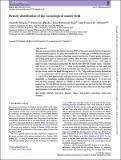Por favor, use este identificador para citar o enlazar a este item:
http://hdl.handle.net/10261/206714COMPARTIR / EXPORTAR:
 SHARE SHARE
 CORE
BASE CORE
BASE
|
|
| Visualizar otros formatos: MARC | Dublin Core | RDF | ORE | MODS | METS | DIDL | DATACITE | |

| Título: | Density distribution of the cosmological matter field |
Autor: | Klypin, Anatoly; Prada, Francisco CSIC ORCID ; Betancort-Rijo, J.; Albareti, F. D. | Palabras clave: | Cosmology: Large-scale structure Dark matter Galaxies: haloes Methods: numerical |
Fecha de publicación: | 2018 | Editor: | Oxford University Press | Citación: | Monthly Notices of the Royal Astronomical Society 481: 4588-4601 (2018) | Resumen: | The one-point probability distribution function (PDF) of thematter density field in the universe is a fundamental property that plays an essential role in cosmology for estimates such as gravitational weak lensing, non-linear clustering, massive production of mock galaxy catalogues, and testing predictions of cosmological models. Here we make a comprehensive analysis of the dark matter PDF, using a suite of ~7000 N-body simulations that covers a wide range of numerical and cosmological parameters. We find that the PDF has a simple shape: it declines with density as a power-law P ∝ ρ , which is exponentially suppressed on both small and large densities. The proposed double-exponential approximation provides an accurate fit to all our N-body results for small filtering scales R < 5 h Mpc with rms density fluctuations σ > 1. In combination with the spherical infall model that works well for small fluctuations σ < 1, the PDF is now approximated with just few per cent errors over the range of 12 orders of magnitude - a remarkable example of precision cosmology. We find that at ~5-10 per cent level the PDF explicitly depends on redshift (at fixed s) and on cosmological density parameter Ω. We test different existing analytical approximations and find that the often-used lognormal approximation is always 3-5 times less accurate than either the double-exponential approximation or the spherical infall model.© 2018 The Author(s). Published by Oxford University Press on behalf of the Royal Astronomical Society. | Versión del editor: | http://dx.doi.org/10.1093/MNRAS/STY2613 | URI: | http://hdl.handle.net/10261/206714 | DOI: | 10.1093/MNRAS/STY2613 | Identificadores: | doi: 10.1093/MNRAS/STY2613 issn: 1365-2966 |
| Aparece en las colecciones: | (IFT) Artículos (IAA) Artículos |
Ficheros en este ítem:
| Fichero | Descripción | Tamaño | Formato | |
|---|---|---|---|---|
| IAA_2018sty2613.pdf | 1,14 MB | Adobe PDF |  Visualizar/Abrir |
CORE Recommender
SCOPUSTM
Citations
26
checked on 10-abr-2024
WEB OF SCIENCETM
Citations
26
checked on 25-feb-2024
Page view(s)
164
checked on 18-abr-2024
Download(s)
270
checked on 18-abr-2024
Google ScholarTM
Check
Altmetric
Altmetric
NOTA: Los ítems de Digital.CSIC están protegidos por copyright, con todos los derechos reservados, a menos que se indique lo contrario.
